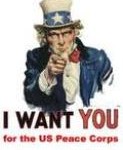B.A. Generalists–The Best and the Brightest???
The early identification of the Peace Corps was that it was an agency filled with B.A. Generalists Volunteers. That evaluation was pretty much true. The majority of Trainees in ’61 and ’62 were June graduates who went immediately back to school that summer and into 2-3 month Training Programs on colleges and universities across the country. Of the first 1,150 Volunteers to join the agency, more than two-thirds had Bachelor’s degrees; one in 10 had an advanced degree–an M.A. or Ph.D.
The Peace Corps HQ building was also full of academic types. In 1961 there were 31 Ph.D’s, 42 M.A.’s, and 20 LL.B’s on the Washington executive and advisory staff. Overseas, in Latin America alone, there were eight doctorates, all graduates of Harvard, Stanford, Yale, Columbia, and the University of Chicago.
So it is not surprising that the agency turned to 36 institutions from the East Ivy League schools, through the Mid-West, and onto California to direct Training Programs. By the summer of 1962 that number would jump to 50 universities training PCVs.
And by doing do–an unintentional benefit to America–was that the Peace Corps paid for American higher education to create academic programs in area studies on dozens of development nations. This was the first time Amereican colleges and universities had programs in the language, history, economy, culture, and government of specific nations. George Washington University, for example, did area studies on Nepal; Georgetown did it for Ethiopia; the University of Hawaii for North Borneo and Sarawak, and Texas Western College for Tanganyika.
Then in the summer of 1962, seven universities in Washington, D.C. pooled their faculties to train 600+ Volunteers. There were 11 projects involved, from fishermen for Togo to teachers for Nepal. This Peace Corps training program was the first to bring together all of the D.C. institutions in a cooperative program, and is was duplicated only once in Puerto Rico where the University of Puerto Rico, the Inter-American University, and the Catholic University of Puerto Rico jointed administered a program to train going to Latin America.
In addition, the Peace Corps in those first years hired five educational institutions to run Peace Corps projects overseas. The first Chile project was administered by Notre Dame on behalf of the Indiana Conference of Higher Education. The West Pakistan project was administered by Colorado State. Michigan State, Harvard and the University of California at Los Angeles worked with the Peace Corps in administering projects in Nigeria.
All of this was working well because these colleges and universities were (for the most part) training teachers. PCVs filled 10 slots on the faculty of Chulalonghorn University in Bangkok; five teachers on the faculty of the University of the East in Venezuela; 25 on the faculty of the University of Nigeria. By the fall of 1962, we had eight teachers at the University of Huamanga in Peru, 10 teachers at the University of Ife in Nigeria, 25 teachers at the University of the Philippines in Quezon City and Los Banos. And I–as a B.A. Generalist from Saint Louis University– was one of 300+ secondary school teachers in Ethiopia. All of us in Ethiopia added 50 to 75 percent to the total staff of the Ethiopian secondary school system when we arrived in Addis Ababa in the fall of 1962.
Peace Corps Volunteer teachers were the dominant (and important) skill that we gave to the developing world in the first few years of the agency.
But what about what the Peace Corps is most famous for: community development PCVs?
End of Part Three
Loving this History. What resources are you using? Frank Mankiewicz’s defining statement about CD in Latin America (circa 1962-63) is a must. Keep it up,
WM Evensen
Peru RCD 1964-66
Good, John.
Of course, it’s the BAGs who were/are central to PC’s success. PCVs bringing Community Development skills to the scene surely add both a luster and a roundness to it. But it is mostly the young BAGs, like us, who were/are going to likely carry a positive cross-cultural sense to a local community. Because, most people in the world kinda like a young American in their midst. And we are most likely to later clear a Third Goal — bringing some understanding of the world out there back home to America.
So, I believe the BAGs are key to the PC’s lasting charm, charisma, and romance.
Beyond that, Peace Corps should again lean on them to reduce it’s totally scandalous Early Termination rate.
Tom Hebert
Dr. Robert B. Textor’s classic, “Cultural Frontiers of the Peace Corps” has case studies of many of the first groups identified by John. The case studies were done by academicians of impeccable credentials who had field experience in the countries or culture areas in which the Volunteers were working. Many of them had also worked for Peace Corps as trainers or consultants.
The book is available on line, as a free PDF download. The best way to access it is to google “Robert B. Textor” and on his webpage, select “publications”.
I wish that the case studies had become the standard for subsequent studies of specific Peace Corps programs. But, they did not.